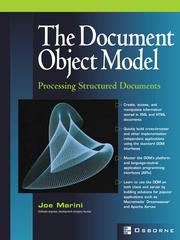
Document Object Model
By Joe Marini
Subjects: Développement, Electronic books, Nonfiction, DOM <Programmierumgebung>, Web site development, Sites Web, General, DOM (Document Object Model), DOM, Computer Technology, REFERENCE
Description: Tap the Power of the Document Object ModelHere’s a practical guide to using the W3C’s standardized DOM interfaces to process XML and HTML documents. Learn the concepts, design, theory, and origins of the DOM. Use the DOM to inspect, navigate, and manipulate a document’s nodes and content; then learn to build useful applications that can easily be ported to any DOM-compliant implementation without re-coding. Get easy-to-follow advice on using the DOM in real-world scenarios such as manipulating document content, creating user interfaces, and offloading processing to the client side. The Document Object Model: Processing Structured Documents will help you flatten your learning curve, standardize programming, reuse code, and reduce development time.Discover the advantages of having a common means of manipulating document information Examine the history and theory behind the DOM's structure, organization, and API Learn to work with various DOM implementations for both client and server Dynamically view and edit a document's elements and navigate its structure Develop document-processing applications that are implementation independent Learn to work with the core data types and interfaces required for effective DOM applications Take advantage of DOM support in Web browsers—including the latest versions of Netscape, Internet Explorer, and Opera Dissect common algorithms and code patterns of DOM processing Build useful, practical DOM applications using a step-by-step approach Debug DOM code in browsers and client/server applications
Comments
You must log in to leave comments.